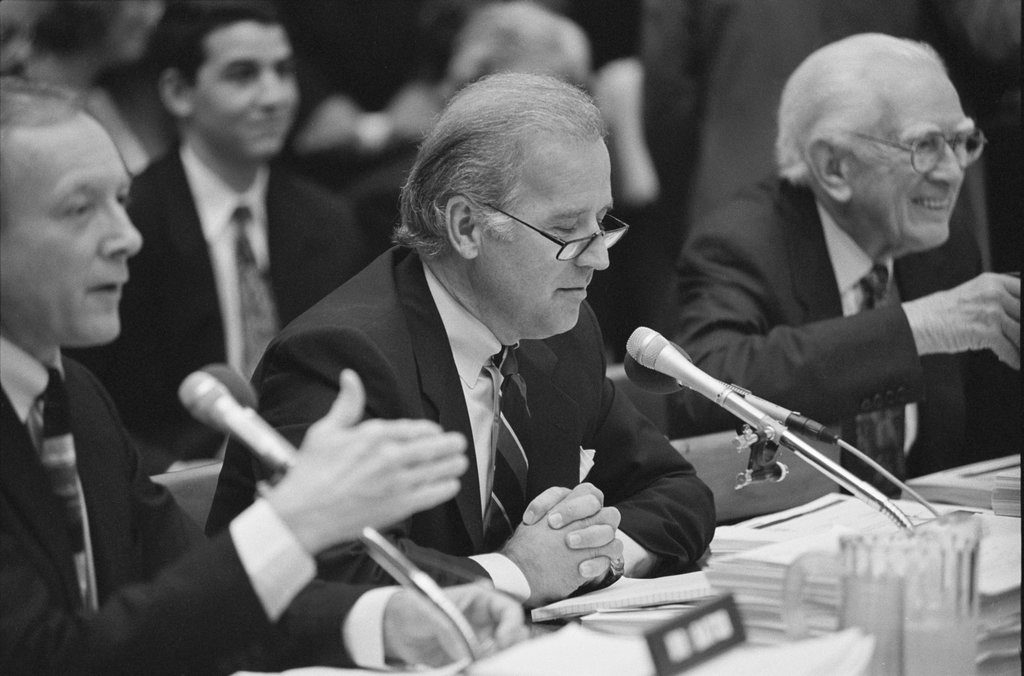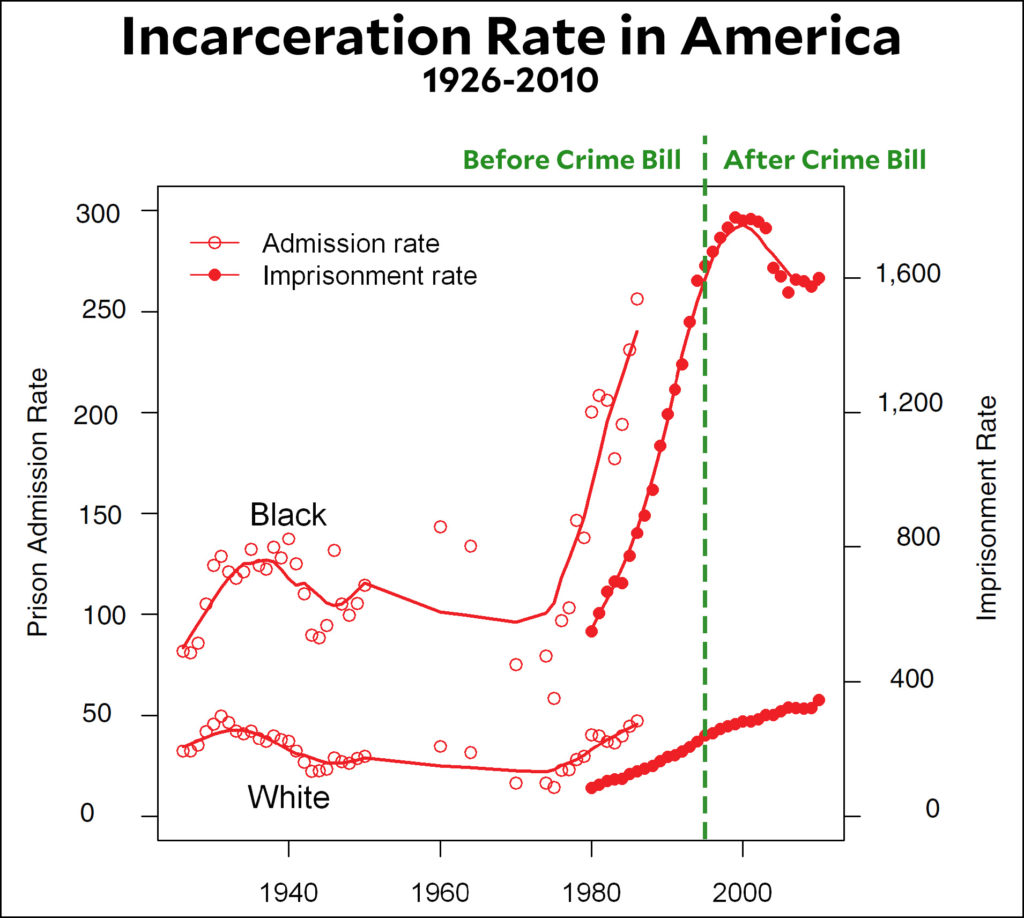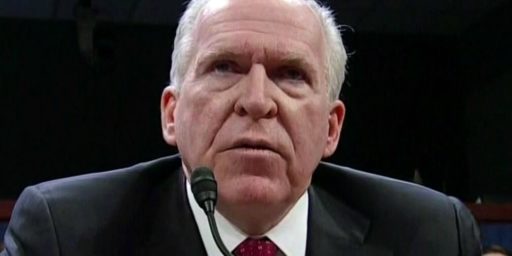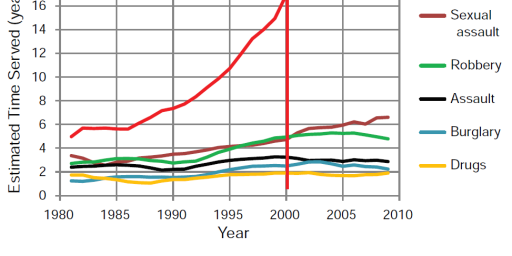Biden and the Crime Bill
The Democratic frontrunner is being wrongly blamed for an explosion in the prison population.

Among the many Progressive complaints about Joe Biden is his role in passing the 1994 Crime Bill. See, for example, this 2015 New York Times article titled “Joe Biden’s Role in ’90s Crime Law Could Haunt Any Presidential Bid.”
As the ranking minority member of the [Senate Judiciary] committee since 1981, Mr. Biden had helped pass two bills establishing mandatory minimums for drug offenses. But as chairman, facing high violent crime rates, a crack cocaine epidemic, and accusations by Republicans that his party was soft on crime, Mr. Biden wanted holistic reform.
The effort, which defined much of his time as committee chairman, culminated in the 1994 Violent Crime Control and Law Enforcement Act, a sweeping, bipartisan bill that touched nearly every aspect of American law enforcement that was signed into law by President Bill Clinton.
More than two decades later, that legislation is once again the subject of fierce debate — this time, as a bipartisan coalition of activists and lawmakers seeks to undo the era of mass incarceration they say the 1994 crime bill helped create.
The rapid shift in mood that those efforts reflect — a reaction to falling crime rates and a renewed attention to issues of racial injustice — could prove one of many hurdles for Mr. Biden if he decides to become a candidate for president.Already, in the 2016 presidential race, criminal justice has commanded a level of attention unseen since the 1990s and has compelled both Republicans and Democrats to have something new to say about it. For Mr. Biden to win support from the young voters who were critical to President Obama‘s election victories, according to activists like Jeremy Haile, he will need to show his views have evolved.
“Any Democrat that is interested in gaining support among the current electorate, particularly the progressive civil rights communities, is going to have to say that previous tough-on-crime policies were a mistake,” said Mr. Haile, federal advocacy counsel at the Sentencing Project.
Four years later, with Biden the frontrunner for the nomination, the criticism has picked up steam:
U.S. Senator Kamala Harris said during a presidential campaign stop in New Hampshire on Wednesday that she disagreed with former Vice President Joe Biden, who said a day earlier that his Senate vote for a 1994 crime bill did not contribute to mass incarceration.
Harris, who previously served as the top prosecutor for San Francisco and then for California, said at a town hall that she has a “great deal of respect” for Biden but disagreed with him on this issue.
“That 1994 crime bill, it did contribute to mass incarceration in our country. It encouraged and was the first time that we had a federal three strikes law. It funded the building of more prisons in the states. And so I disagree, sadly,” Harris told reporters
Even the also-rans are taking their shots:
New York City Mayor Bill de Blasio (D), who is running for president, took aim Sunday at the field’s front-runner, former Vice President Joe Biden, over his support for the 1994 crime bill.
Speaking on CNN’s “State of the Union,” de Blasio called Biden’s work on the bill “a huge mistake.”
“That crime bill was one of the foundations of mass incarceration and a very painful era in our nation’s history,” he said. “[Biden] and anyone else has to be accountable for every vote they take and what’s on their record. And I think that was a huge mistake.”
De Blasio added that the crime bill and other federal policies “were a big part of why untold thousands of people and families had their lives entirely disrupted and in many ways destroyed.”
“We’ve got to break out of that, and anyone responsible has to be accountable,” he said.
And, in a perplexing move, the not-at-all-racist President is joining in:
President Trump and his reelection campaign are opening up a fresh line of attack against Joe Biden, hitting the former vice president for his central role in a 1994 crime bill that has left Biden vulnerable to criticism from his right and his left.
As he prepared to leave Tokyo on Tuesday, Trump eviscerated Biden over his efforts behind the Bill Clinton-era law — one centerpiece of the tough-on-crime movement of the 1990s that Biden is being forced to confront on the campaign trail more than two decades later.
“Anyone associated with the 1994 Crime Bill will not have a chance of being elected. In particular, African Americans will not be able to vote for you,” Trump said in a pair of tweets going after Biden, whom the president repeatedly referenced during his four-day trip to Japan. “I, on the other hand, was responsible for Criminal Justice Reform, which had tremendous support, & helped fix the bad 1994 Bill!”
The blacks will surely flock to Trump if Biden is the nominee.
It turns out, however, that the notion that the Crime Bill set off a crisis of mass incarceration simply isn’t true. Kevin Drum ran the numbers and produced this chart:

He observes,
As you can see, the 1994 crime bill had no effect on this trend. Incarceration rates started skyrocketing in the late 70s as a response to rising crime rates, and after the crime bill passed the increase in incarceration started to slow, eventually peaking in 2000.
The crime bill, of course, deserves credit for slowing incarceration no more than it deserves blame for increasing it. It was a null factor. Incarceration increased as crime rates increased, and then started to fall about a decade after crime rates started to decline. Mass incarceration in the US was a panicked response to mass crime, and the 1994 crime bill had little effect on it one way or the other.
I don’t really care what anyone thinks of Joe Biden, but liberals should stop inventing reasons to blame him for things he isn’t responsible for. The 1994 crime bill (a) included a lot of good ideas, (b) included some bad ideas at the insistence of Republicans, (c) had nothing to do with skyrocketing incarceration rates, (d) was supported by most black lawmakers, and (e) was a reaction to the fact that violent crime really was high, and nobody at the time had any reason to think this was likely to change.
So . . . how did the myth get started?
An NBC News fact check explains,
Biden claimed that the 1994 bill did not lead to mass incarceration.
“Folks, let’s get something straight, 92 out of every 100 prisoners who end up behind bars are in a state prison, not a federal prison,” he said. “This idea that the crime bill generated mass incarceration, it did not generate mass incarceration.”
Though the bill was not the root cause of “mass incarceration,” it was “the most high-profile legislation to increase the number of people behind bars,” according to a Brennan Center analysis in 2016.
The crime bill granted states billions to build prisons if they passed laws requiring inmates to serve at least 85 percent of their sentences, the Brennan Center said, noting that 30 states introduced or amended laws between 1995 and 1999 so that they would be in compliance and receive the money. By 1999, 42 states had “truth-in-sentencing” laws on the books, which contributed to an increase in imprisonment.
“By dangling bonus dollars, the crime bill encouraged states to remain on their tough-on-crime course,” the Brennan Center wrote.
That seems plausible enough: there was indeed a rash of prison building, mostly via for-profit corporations. But Drum’s chart (compiled from National Science Foundation data) shows that the increase in incarceration after the bill was simply a continuation of a long trendline—and actually soon reversed itself.
The Brennan Center study itself offers this:
First, the good: Though the crime bill was not responsible for the entire drop in crime, it likely helped — not by locking people up, but by putting more cops on the street, studies show. It provided funding for 100,000 new police officers and $14 billion in grants for community-oriented policing, for example. From 1990 to 1999, the number of police officers rose 28 percent, from 699,000 to 899,000, partly funded by the crime bill.
Research also indicates smarter policing tactics, like the ones funded by the bill, and social and economic factors — like an aging population and decreased alcohol consumption — played a role in the crime decline as well.Crime had already started declining before the bill passed. From 1991 to 1994, crime dropped 10 percent and violence decreased by 5 percent. From 1994 to 2000, crime fell an additional 23 percent, with violent crime dropping by almost 30 percent. All of the above contributed to the fall.
Then there’s the bad: Although incarceration was already rising steadily before the crime bill, several of its provisions helped increase incarceration even further. Nevertheless, this increase had little impact on America’s subsequent drop in crime.
From 1970 to 1994, the rate of imprisonment exploded 400 percent, to 387 per 100,000 people. From 1994 to 2009, imprisonment continued to rise, doubling.
The crime bill contributed to this increase in incarceration. First, it banned 19 types of semiautomatic assault weapons, authorized the death penalty for dozens of existing and new federal crimes, and instituted a federal “three strikes and you’re out” provision.
But those facets were far less pernicious than how the crime bill influenced states to increase their prison rolls. The bill granted states $12.5 billion to build prisons if they passed “truth-in-sentencing” (TIS) laws, which required inmates to serve at least 85 percent of their sentences.
A 2002 Urban Institute study found that between 1995 and 1999, nine states adopted TIS laws for the first time, and another 21 states changed their TIS laws to comply with the crime bill’s requirements and then apply for funding. By 1999, a total of 42 states had such laws on the books, sustaining an increase in imprisonment.
The crime bill, however, was just the most high-profile legislation to increase the number of people behind bars. On their own, states passed three-strikes laws, enacted mandatory minimums, eliminated parole, and removed judicial discretion in sentencing. By dangling bonus dollars, the crime bill encouraged states to remain on their tough-on-crime course.
The Crime Bill was mostly a good thing, then. Not only did putting more police on the streets help, we helped fund training to make them more professional.
The bad? It’s innumeracy. The Brennan analysts simply look at the raw numbers—the rate doubled!—without paying attention to the trend line. It would have doubled regardless.






Kevin Drum has a very interesting theory about why crime rates started to drop in the 1990s, and have continued to do so. He ties it to the elimination of lead in gasoline in the 1970s. By the 1990s, the children born after lead was eliminated were reaching young adulthood, the age at which criminal involvement peaks.
There’s not a lot of evidence that putting lots of cops on the streets dramatically cut crimes rates. There IS, however, a lot of evidence that it contributed to the militarization and increasingly aggressive tactics used by police. And there is a huge amount of evidence that the 1033 program, which turns over military equipment to police and has been enthusiastically supported by Biden, has contributed to the rise of the warrior cop. 80,000 SWAT raids a year, mostly on rubber-stamp warrants and against poor people of color, is the true legacy of the 90s crime laws.
The 1994 bill did not occur in a vacuum. It was a culmination of years of increasingly draconian laws. And Biden was a cheerleader for all of it. Trump is the last person who can call him out on this (see, e.g., the Central Park Five). But let’s not whitewash his record here. He’s as much responsible for mass incarceration and overly-aggressive policing as any politician in America.
@Monala: There is a lot of research pointing to that. Different countries banned lead at different times and saw peaks and declines in violent crime consistent with the timing. It also explains why the biggest increase in violent crime happened in inner cities. Who gets more exposure to lead, a fetus in the middle of a cornfield in Nebraska, or a fetus in downtown Chicago surrounded by 6 million cars?
If I had to bet money on the Dem nomination right now I’d put it on Warren.
Professional? Maybe in the sense that we increased the distance between police and the populace they are supposed to serve allowing an “us vs them” mindset that promotes, let alone excuses, violence and violations of civil rights.
@Hal_10000:
I’m basing my analysis on the linked Brennan Center study, from which I’ve quoted extensively. They’re both highly credible, housed at one of the nation’s elite universities, and regarded as left of center (they’re named after one of the most famously liberal Supreme Court justices of the modern era.) You can debate it but dismissing it out of hand doesn’t advance the ball.
@SKI:
Did we? There’s been a huge push over the last quarter century toward the Community Policing model. There’s more and better training available thanks to Federal funding, including the National Academy at Quantico.
It’s true that there has also been a militarization of police over the same period. And that there are still a lot of unprofessional cops out there, especially in smaller and poorer municipalities. But I think things are mostly better.
@James Joyner:
How much direct experience did you have with big city policing in the past 20 years to base your thinking on? I’m guessing none.
My now thankfully ex-brother-in-law was a cop in Baltimore City. He and his colleagues were trained to treat the citizens of the city as enemies. To do *anything* they needed to to “get home alive” – and were taught that the risk of not coming home alive was huge. They were, quite literally, “professionalized” to have rules of engagement more forgiving of violence than on the streets of Baghdad.
In many ways, the “training” the police got was basically “militarization” under the 1033 program. See, e.g., https://www.charleskochinstitute.org/issue-areas/criminal-justice-policing-reform/militarization-of-police/
Also: https://www.motherjones.com/politics/2014/08/america-police-military-swat-ferguson-westcott-tampa/
@SKI:
A lot of police, including many involved in recent shooting, get “killology” training where they are given ROE that our military would never follow and told that they day they shoot someone, they’ll go home and have the best sex of their lives. Remember that Stephen Mader was fired for *not* shooting someone while the cops the roared up and opened fire were praised as heroes.
@SKI:
I’m not claiming first-hand experience. Instead, I’ve cited both Drum’s statistical research and a comprehensive study by the left-leaning Brennan Center. Your brother-in-law’s anecdotal experience is not a counter to that.
Moreover, I’m not making a claim that police in this country are mostly professional. Indeed, I don’t think that’s the case. We have tons of issues that I’ve pointed to repeatedly in the history of this blog. I’m merely—again, bouncing off of the Brennan Center study cited in the OP—making a claim that the Crime Bill (signed by Bill Clinton) funded training programs that helped professionalize law enforcement compared to the status quo ante.
Drum dropped the ball on this one. Yes, the federal sentencing law only affected the small percentage of crimes that were tried in the federal system and so did not affect the overall incarceration rate that much, but that law was directly modeled on the state laws that caused the tremendous rise you can see in the chart a few years earlier. I happen to agree with his overall point but feel this chart is misleading.
It may be hard for those who weren’t adults during that time to imagine just how violent and crime ridden the United States was. NYC literally had ten times the murders it has today. (Anecdote is not data but FWIW the very first time I ever went to the Port authority bus terminal in Manhattan, somewhere around ‘92, I spied a cop and went over to ask which exit to take. It was only after he directed me to the correct staircase that I realized there was blood on the floor and he was standing in front of a covered body.) Rapes, beatings, mugging, home invasions were all at levels that are (obviously) unimaginable today. Everyone had stories about gangs coming into a subway car and terrorizing and robbing the riders. And New York was the norm, not the exception. Today it’s almost impossible to find affordable housing in Manhattan but back then there were so many buildings abandoned due to the dangerous neighborhoods that an especially odd type of crime prospered for a while. The bricks of the building were worth more than the buildings themselves so work crews would descend on them overnight and literally dismantle them for parts.
Did the politicians at the time over react? Yes. Did they get into a spiral of trying to out tough each other in crime and end up with inhumanely harsh sentences? Yes. But it didn’t happen in a vacuum. It’s what these politician’s constituents, regardless of color, demanded every day.
People who harshly judge these politicians should think about the things they are calling for the laws to get tough on today. The things they feel should be handled with less benefit of the law given to the accused. Today it may be only a few types of injustice that they say need special laws and considerations, but that’s a slippery slope.
@MarkedMan:
Oddly, the vast bulk of your comment seems to restate Drum’s conclusion.
What I got from this is that Dennison is scared of running against Biden.
@James Joyner:
1. I didn’t just cite his experience which is anecdotal but also relevant. I also cited the Koch Institute and the Mother Jones piece. But, if you want one specifically on what I’m talking about? Here ya go: https://www.theatlantic.com/national/archive/2014/12/police-gun-shooting-training-ferguson/383681/
2. Drum’s article was on a different issue – whether the crime bill led to more incarceration. You don’t get to cite them for the principal that the funding for police led to a better, less radicalized, police force.
Simlarly, the op-ed from Chettier and Eisner of the Brennan Center, written for MSNBC, doesn’t actually claim that the Crime Bill led to more professional policing. It does claim that “smarter policing tactics” was funded by the Bill but provides no actual research to indicate that such funding did anything to improve police performance with respect to “professionalizing” the police and limits its impact to a basket of “factors” including an aging population, economics and environment.
Ultimately, your conclusion that “The Crime Bill was mostly a good thing, then. Not only did putting more police on the streets help, we helped fund training to make them more professional.” is unsupported by anything you posted. The arguments *against* the Crime Bill are appropriately shredded but you didn’t actually provide anything to support that the training that the Crime Bill funded has been a force for good.
Let’s be honest, James. You have never had to worry about hyper-aggressive policing. You haven’t felt, or even seen, the impact of dramatically increasing the number of cops or the impact of them being trained to treat the population as the enemy. You don’t have an answer for the Gallup Poll trendlines on the question of whether African Americans reported being treated unfairly by cops in the past 30 days. You don’t have to worry about it.
@SKI:
Again, I’ve written dozens of articles over the years on police misconduct, the inhumanity of our prison system, and the like. I’m just saying that the Crime Bill isn’t a principal reason for any of that and may well have improved the system somewhat.
Otherwise, fair enough on the Brennan Center op-ed. It cites “research” that “indicates smarter policing tactics, like the ones funded by the bill … played a role in the crime decline” but doesn’t tell us what said research is.
@James Joyner:
James, just because the federal government throws money at grant applications promising “community policing” doesn’t mean the agencies which receive the money actually implement anything close to the accepted definition of “community policing”.
For many agencies, it’s just another revenue stream for agencies doing the same things they’ve been doing for decades. For those that actually complete the training and support implementing a “community policing” model, how much buy-in do they get from their superiors and politicians?
@James Joyner: @James Joyner:
As I said in the comment:
It might have been better stated that I feel his analysis of this chart is misleading. The chart itself is fine.
@MarkedMan:
To this point, at the peak year (1990) 2,600+ murders occurred in NYC. In 9/11 approximately 3,000 people died. So we were close 9/11 death tolls yearly for NYC from 1972 (the first time the murder rate passed 2000) to 1994 (the last time it was above 2000).
Contrast this with Chicago (currently considered one of the highest murder rates in the country) where 530 murders happened last year.
@mattbernius: I just looked that up. 289 in NYC last year. Wow.
That tetraethyl lead was some evil shit.
@Teve:
And at the time conservatives stated that simply removing it was reckless and that even though we knew lead was extraordinarily bad and directly tied to brain damage and violence, we didn’t yet know enough about it to regulate. Scientists disagreed. Oh and by the way it would destroy the economy because lead was vital to the internal combustion engine and engines would smash themselves to bits if we removed it.
Does that thinking sound familiar?
@Teve: You may want to learn about Thomas Midgley.
https://en.m.wikipedia.org/wiki/Thomas_Midgley_Jr.
Spoilers: after being instrumental in developing and promoting leaded gasoline, he served the same role with CFCs, and then accidentally killed himself with an elaborate pulley system he invented to help move around his body after he got polio, sparing everyone from whatever he was working on next.
@MarkedMan: Evil government taking away our libertarian freedom to get brain damage and poor impulse control from lead! We’re being denied all those Freedom Murders™!
@Gustopher: his life was written by Douglas Adams, I think 😀
@Teve: It’s one of those rare moments when you give a small cheer for polio.
Midgley is also described as the single organism that has had the most effect on the atmosphere.